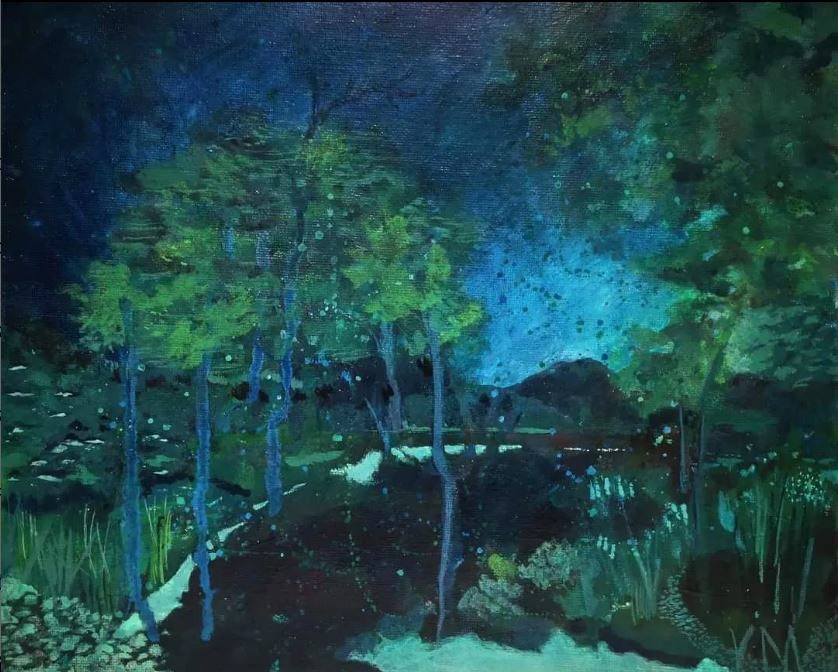All the paintings in this show relate to the genre of landscape in some way. Some of the paintings relate to a particular place, a memory of a place, a question about place. Some of the paintings relate more to the process of painting itself, the unfolding layers, intuitive responses, and internal motivations that drive a painting fuelled by an aspect of the environment around us. All of the paintings in this show reveal how the practice of landscape painting aligns and diverges for painters today.
Asking 3 painters what landscape painting means to them today reveals many answers. In opposition to what a romantic notion of landscape painting might suggest, these painter’s responses reveal ambiguous, multi-faceted, and often murky relations with their surroundings. Duration and repeated processes seem as critical to painterly modes of research as intuitive, sudden and exploratory revelations in the studio. Collectively, the paintings reveal varying degrees of irreconcilability between the process of observation and perception, imagination, image-making, and abstraction, and the often wild, sticky, and tricky manoeuvring between these aspects. The resultant works acknowledge and revel in the slippages between aspects of the real and the imagined, and all the different paths that open up in between.
Ginny Elston
Ginny Elston is an artist-researcher-teacher based in Scotland, with a background in Art History, Fine Art and the Humanities. She is currently working towards her PhD from Glasgow School of Art, where she is developing a thesis based on the connections between formalism, new materialist philosophies, and painting and sculpture. Working intuitively with colour, shape and light in response to the world around her, Ginny is inspired by both artificial and natural worlds, and the myriad of forms and textures they provide.
Her recent paintings feature layers of pigment, paint, and varnish that work against a sense of observed place and space. Deeply embedded in her paintings are messages to loved ones, hidden or secondary images, or a nod to a particular poet or musician. Paintings frequently start with a combination of ‘impossible’ colours, such as how can a cadmium red work alongside a cerulean blue? How can chartreuse live alongside magenta and violet without making us feel queasy? The process of each painting is one of image-seeking, allowing the painting to unfold on its own terms through colour relationships.
Valerie McLean
Valerie McLean is an Artist, Educator and Art Writer. She is Course Leader for the Friday Yearlong Painting Course at Leith School of Art and teaches both Theory and Practice at Edinburgh College of Art. She has exhibited widely and is a professional member of Visual Arts Scotland.
At the heart of her practice lies a deep sense of connection to the natural landscape. Like the Romantic painters of the past, she seeks to capture the awe-inspiring power and fragility of the world around us. However, this sense of wonder is tempered by a growing anxiety over the rapid transformation of our environment. As the landscape she experiences visually shifts and evolves, she find herself grappling with the unsettling reality of the environmental crisis.
The limited palette used in the paintings in this exhibition serves to focus on the underlying emotional and psychological resonances that emerge in our interactions with the natural world. Here, the interplay of painting, reality, memory and imagination combine to create visions of the landscape which oscillate between the melancholy and the hopeful.
Paul Mowat
Paul Mowat is a painter who studied at Edinburgh College of Art in the nineties. He has divided his time between teaching, mentoring, curating and painting in his studio in Leith.
Although the subject matter might be straight forward enough, landscapes, portraits: interiors: there’s an otherness in the paintings that suggest something else is going on. The source material, is never singular. The landscapes might draw on memory, the portraits: imagined, and the observed interiors intertwined with dreams. Literature informs the work as do films, journeys... serendipity...the stuff of life.
He works often and prolifically, sometimes painting over images started years earlier, merging time in works whose initial meaning becomes lost or altered. Like our memories, the source becomes unreliable, imagery, often repeated and manipulated until something suggests itself and becomes apparent.

